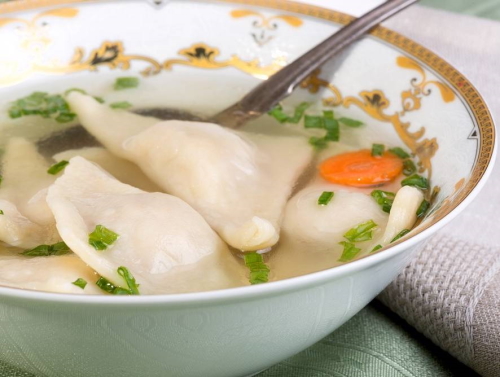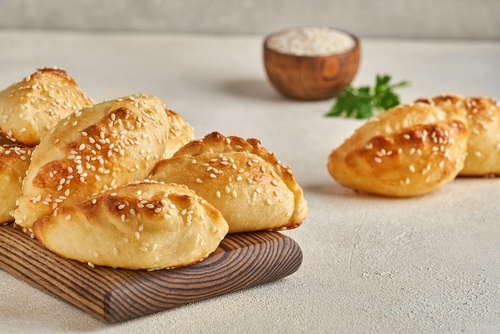From hamantaschen to kreplach to the lesser known graybeh and “Haman’s fingers,” food has been a staple of Jewish tradition and comforting familiarity since the dawn of time. For a Yom Tov that discourages sobriety (Purim), it’s the one constant familiar face in the room.
Purim is the embodiment of Judaism; From fasting to feasting, seriousness to frivolity, suffering to salvation, and as our one holiday in which cutting loose is the norm (and even highly encouraged), it defines our sense of family, tradition, and community. Few things contribute to a sense of pride, comfort, and belonging more than traditional food our grandmothers perfected through the ages.
While traditional Purim foods vary greatly from community to community, the good news is that we’re all willing to share. There’s no DNA test required to try delectable dishes from different regions and cultures. (Although I’m sure ma’amoul tastes better once you discover that you are three percent Syrian.)
Ashkenazi Purim Food Traditions

Hamantaschen pastries are synonymous with Purim, and given that there are conflicting explanations of what they symbolize, it’s highly recommended that you eat at least one for every possible reason (just to be safe).
The simplest and most literal translation for the word is that it refers to “Haman’s Tash” (the Yiddish word for “pocket”), which held in it the money to bribe King Achashverosh for his evil plans. Other versions suggest that the shape of the cookies signify his hat’s shape or his bent ears. Regardless of which meaning you subscribe to, you can enjoy these delicious treats with this Hamantaschen recipe.
Another fundamental part of every Ashkenazi Purim meal is stuffed cabbage and/or kreplach. While these meat-stuffed delights are enjoyed during multiple holidays, they have a special meaning on Purim. As you know, G-d’s name is notably absent from the Megillah, and the stuffed delicacies signify that Hashem is ever present, even when you can’t see him – much like the meat hides in its doughy outer shell. Find recipes for stuffed cabbage and kreplach.
Iraqi Purim Food Traditions:

Iraqi Jews would prepare baaba cookies to send to family and friends for Mishloach Manot. They would also eat sambusak, which is a protein-filled dough that’s deep-fried and full of aromatic flavor. They use all sorts of fillings such as chickpeas, meat, or even cheese.
Yet another symbolic dish served in many Jewish homes on Purim is chickpeas and beans. Perhaps not as exciting to some as some of the other foods on this list, but legumes were an integral part of Esther’s diet in the palace for obvious reasons. I think the recipe is self-explanatory, but just to be on the safe side, I’ll put my favorite version below in case you need a refresher:
Recipe:
Pour chickpeas into anything that holds food.
Add beans.
Eat.
Syrian Purim Food Traditions

Our next guest on the Purim list has a tough act to follow (the chickpeas and beans might seem impossible to top), but luckily these goodies are more than up for the task.
Back in the day, there were no ready-bought Mishloach Manot. People used to make the pastries themselves and exchange plates. For example, the Syrians made traditional pastries, such as ghraybeh or ka’ak and ma’amoul.
Italian Purim Food Traditions

Italian Jews eat vegetable pastry turnover called Buricche. It symbolizes the vegan diet Esther kept in the palace, enabling her to hide her Jewish identity. The linked recipe is a reimagined sweet, festive pastry inspired by the Italian tradition.
Moroccan Purim Food Traditions
Ojos de Haman (Haman’s eyes) are prepared by Moroccan Jews. These are rolls baked with almonds and topped with two hard-boiled eggs. One of the men at the table plucks out the egg, symbolizing the destruction of Haman.
Moroccans also made sweets platters featuring chebakia and sweet almond cigars, aka “Haman’s fingers.”
Rhodian (Greek) Purim Food Traditions
Another bread is Folares, enjoyed by Rhodian Jews. It’s meant to symbolize Haman’s head. Its dough is wrapped around a hard-boiled egg.
Bulgarian Purim Food Traditions

Another exciting food is Caveos di Aman, a Bulgarian dish consisting of stringy pasta served with olives and hard-boiled eggs representing Haman’s hair. It’s eaten to commemorate Haman’s cruelty.
French Purim Food Traditions
Palmiers is a French pastry served on Purim to symbolize Haman’s misshapen ears. It’s a classic cookie that you can make super-duper easy by using store-bought puff pastry.
Although our traditions vary somewhat, one thing is sure; you won’t stay hungry. Are you ready to try a new tradition?
As Slay Copy Inc.’s founder, Goldy Buxbaum helps business service providers reach more clients by combining business strategy with web writing. Check her out on Linkedin to see how you can grow your business.






